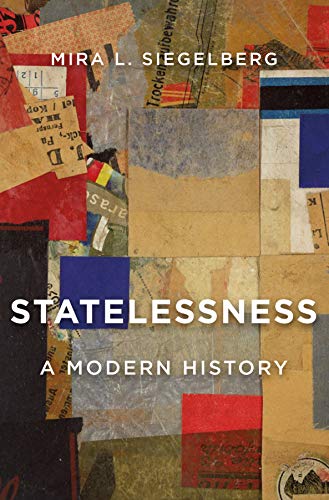

This is part of our special feature, Displacement, Memory, and Design.
The United Nations Refugee Agency estimates that at least 12 million people are either legally or effectively stateless. Given the increasing likelihood of climate change-related forced displacement alongside continued social and military conflict, that number is expected to grow. Frequently confined to camps or interned, these individuals’ lack of state affiliation means that most have limited access to resources ranging from food to employment and medical care. Yet, despite the fact that statelessness has been a global crisis for decades, there is currently no clear solution to the situation and limited juristic discussion on the topic.
Mira Siegelberg’s Statelessness: A Modern History, therefore, offers a necessary exploration of the development of statelessness as a Western philosophical and jurisprudential concept in the early and mid-twentieth century. To trace that history, Siegelberg—currently lecturer at the University of Cambridge—draws heavily on legal scholarship from across Europe as well as debates in the League of Nations (LON) and United Nations (UN). The author uses that material to “reconstruct and clarify the arguments” shaping a “shared understanding of citizenship and non-citizenship” (3). In the process, Siegelberg also shows how international European lawyers used statelessness as a measure for the limits of state authority and the reach of international law before it became a marker of the failures of the international order. The bookexamines the voices of a diverse range of people, including individuals who were legally or effectively stateless. However, by focusing on international discussions at the LON and UN between the 1910s and 1960s, the volume privileges a white, “Western” perspective, in spite of dozens of countries being mentioned in passing (Guatemala, China, and others), as well as a few decolonial moments across the world.
Siegelberg divides Statelessness into six chronologically organized, tightly written chapters that are further implicitly divided into three sections placing the concept of statelessness in contemporary, European, and supranational organizations’ debates around state sovereignty and citizenship. In each section, the author not only lays out some of the major, often contending, philosophical strains of thought—predominately in Europe—shaping the concepts at stake, but also addresses their legal implementation. Using an array of examples, Siegelberg illustrates the divergent methods state governments and other groups used to implement supranational recommendations and law, often to the horror of the theorists involved.
At its core, this history of the idea of statelessness offers a fascinating narrative exploring the transition of a concept from a thought exercise into a continually reinterpreted legal construct. Siegelberg combines the work of historians such as Peter Gartrell, who has examined statelessness as part of the broader plight of displaced persons, refugees, and other groups forced into migration during the Great War and interwar period, with case- and juridical-focused studies by political scientists and lawyers. In the process, the author offers a careful analysis of the theoretical development of the legal concept across disciplines and the ways it changed within specific historical contexts. As the book demonstrates, it was hardly coincidental that British courts turned “statelessness” into a legal category as lawyers and philosophers debated the concepts of state sovereignty, the structure of empire, and the nature of the nation at the end of the Great War. One relevant case, Stoeck v. Public Trustee (1921), involved a businessperson—Max Stoeck—from Prussia claiming statelessness in a British court. In ruling for Stoeck, British judges effectively argued that Britain had the right to step into what was, at that time, largely viewed as another state’s prerogative and to evaluate another state’s (here Germany) legal relationship to its citizens. With the millions of displaced peoples across Europe at the time, the new legal category became a focal point for state governments and members of supranational communities to examine the nature and limits of the relationship between the individual and the state. For Siegelberg, it was then that statelessness transformed into a marker for the limits of the twentieth century international orders as administered by the LON and UN.
The book also shows how supranational and state emphasis on the relationship between ethnonational identity and legal citizenship added to the growing number of stateless individuals across Europe both incidentally and intentionally. Especially in the aftermath of the Great War, many in Europe began to argue that Europe itself needed to be reorganized around national communities in order to promote peace.[1] Furthermore, as scholars such as Carole Fink and Mark Mazower have discussed, the LON insisted the nation-state was responsible for advocating for nationals both domestically and abroad, a claim which the Nazi party would seize to justify the Nuremberg Laws (1935), the annexation of the Sudetenland (1938), and the Second World War.[2] Siegelberg adds a new line to these studies by shifting focus from the nation-state restrictively to other collectivities and peoples. For example, the imposition of national categories in the new states where the Austro-Hungarian Empire had existed effectively excluded multiple minority groups from state membership. Groups like the Nazis then added to those numbers of de facto stateless individuals with categories of citizenship that claimed subjects even as the state denied them rights or protection. If national membership hinged on ethnic identity, then minorities did not fit within the nation-state. Combined with fascist ideologies, this stance contributed to the “creation of statelessness as a mass phenomenon” (137).
As a mass phenomenon, statelessness meant that human rights thinkers saw it as an essential component of international law. Where some scholars like Samuel Moyn argue that human rights did not exist before the creation of human rights law, [3] Siegelberg shows how lawyers such as Boris Mirkine-Guetzevitch pushed for “‘international human rights’” in the 1920s (123) in part to address the situation of the stateless. While many thinkers in the early twentieth century emphasized rights in terms of ethno-national communities, the associated problem of statelessness pushed toward different methods for ensuring rights. For many, the key was to divorce the connection between rights and ethnic groups and, instead, attribute rights to individuals. This individualization of rights came to fruition in the aftermath of the Second World and was inscribed in the Universal Declaration of Human Rights (UDHR), which identified an individual right to nationality (roughly synonymous with citizenship) and the state-protections that came with it. Yet, as many theorists like Hannah Arendt argued, the UDHR did not go far enough. For the UDHR to function as intended, the state could not have the right to deny citizenship to people within its borders. By weaving together these representative theoretical discussions into a clear, narrative thread, Siegelberg highlights how the UN’s limited reach and emphasis on the state’s control over citizenship law meant millions of people would continue to be excluded. Despite these shortcomings, however, the author emphasizes that organizations such as the UN nevertheless promote a measure of stability that might otherwise be missing. In doing so, Siegelberg exposes the binary of “success” and “failure” as an insufficient measure for evaluating these supranational organizations.
Statelessness is a must-read for scholars and legal professionals studying citizenship and/or working on immigration, political theory, and human rights as it provides a needed engagement with statelessness as a contentious concept. In tracing the shift in the European international philosophical discussion of statelessness and the centrality of the concept in the formation of the twentieth century state and international order, Siegelberg emphasizes the fictive and plastic nature of the concepts of the state, citizenship, and sovereignty, as well as the distance between legal theorists’ imagined social order and reality. The book also emphasizes that legal concepts can change and will keep changing. Still, readers should be aware that the book has limits. For all its excellence, its focus on the recorded history of events at the international level raises questions about scholars’ responsibility in reaching into historical silences. It also presumes a significant amount of background knowledge about the twentieth century world, likely making it difficult to read for undergraduates or a general public. Nevertheless, the writing style and approach to the content make this volume eminently accessible and highly enjoyable. This reviewer highly recommends it as a fascinating and important read.
Brittany Lehman has been with Boston College since 2019, where they are a Senior Liaison Librarian for History and a Professor of the Practice. Previously, they completed a PhD in history at the University of North Carolina at Chapel Hill and published Teaching Migrant Children in West Germany and Europe, 1949–1992 with Palgrave Macmillan in 2018. Their scholarship continues to focus on European migration history and digital humanities, with additional publications on the politics of deportation and West German involvement in decolonization. Currently, they are working on digital scholarship projects associated with migration.
Statelessness: A Modern History
By Mira L. Siegelberg
Publisher: Harvard University Press
Hardcover / 318 pages / 2020
ISBN: 9780674976313
References
[1] Stella Ghervas, Conquering Peace: From the Enlightenment to the European Union (Cambridge, MA: Harvard University Press, 2021).
[2] Carole Fink, Defending the Rights of Others: The Great Powers, the Jews, and International Minority Protection, 1878-1938 (Cambridge: Cambridge University Press, 2006); Mark Mazower, “Minorities and the League of Nations in Interwar Europe,” Global Minority Rights, Joshua Castellino, ed. (New York: Routledge, 2017): 17-34.
[3] Samuel Moyn, The Last Utopia: Human Rights in History (Cambridge, MA: Harvard University Press, 2012)




